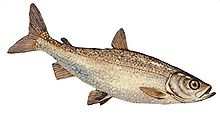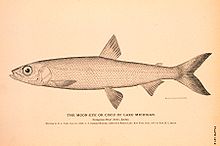- Coregonus hoyi
-
For other uses, see bloater.
Bloater 
Conservation status Scientific classification Kingdom: Animalia Phylum: Chordata Class: Actinopterygii Order: Salmoniformes Family: Salmonidae Subfamily: Coregoninae Genus: Coregonus Species: C. hoyi Binomial name Coregonus hoyi
(Milner, 1874)Synonyms Argyrosomus hoyi Milner, 1874
The bloater (Coregonus hoyi) is a species of freshwater whitefish in the family Salmonidae. It is a silvery-coloured herring-like fish, 25.5 centimetres (10.0 in) long. It is found in most of the Great Lakes and in Lake Nipigon, where it inhabits underwater slopes.
Contents
Description
The bloater is a small silvery-coloured whitefish with a pink and purple iridescence. It has a greenish tinge above, and a whitish belly.[2] It is very similar to the kiyi, from which it may be distinguished by its lighter upper lip and smaller eye.[3] Its body is deepest at its middle, it has small and pale fins,[4] and it has 40–47 long gill rakers.[3] The discoverer of the bloater, P. R. Hoy, thought it to be "the most beautiful of the white fish".[2] It reaches a maximum total length of 37.0 centimetres (14.6 in) and commonly is 25.5 centimetres (10.0 in).[5]
Distribution
The bloater is native to all of the Great Lakes except Lake Erie, and in Lake Nipigon. Across its range it is in decline, and it is listed as Vulnerable to global extinction by the IUCN Red List.[1] It is extirpated in Lakes Ontario and Nipigon, is uncommon in Lake Michigan and is in decline Lakes Superior and Huron.[3][4] This decline is caused mostly by predation by the alewife,[6] and also by sea lamprey predation[7] and pollution.[8]
Taxonomy and etymology
The specific epithet of the bloater is given after Dr. P. R. Hoy of Racine, Wisconsin. Dr. Hoy collected the first specimens of this species in 1870 while dredging in Lake Michigan at least 16 miles (26 km) off Racine, at depths of 50 to 70 fathoms (90–130 m). Hoy did not describe the fish himself, but had icthyologist James W. Milner name the species.[9] Milner placed it in the genus Argyrosomus, now considered a junior synonym of Coregonus, the genus in which the bloater is now placed.[4] The generic name Coregonus, given by Carl Linnaeus in his 1758 tenth edition of Systema Naturæ, is derived from Greek and means "angled eye", referring to the tilted pupil of whitefishes.[10] It is closely related to the cisco or lake herring, Coregonus artedi, and the shortjaw cisco, both of which it is known to hybridise with.[2] The common name of the bloater comes from the swollen appearance it has after being brought up from the deep waters it inhabits.[3] The same name is given to certain type of smoked herring in Britain, which is swelled in its preparation.[11]
Ecology and behaviour
The bloater is found at depths of 30 to 198 metres (98 to 650 ft).[5] There it inhabits underwater slopes, and is tolerant of temperatures between 34.7 to 52.4 degrees Fahrenheit (1.5 to 11.4 Celsius). When it is brought to the surface its gas bladder expands, giving it a swollen appearance.[2]
The bloater feeds mostly on animals living at the lake bottom (zoobenthos), but will sometimes eat small drifting animals, or zooplankton. The shrimp Mysis diluviana, and the amphipod Diporeia hoyi, also named after P. R. Hoy, are recorded as food items.[5] The lake trout, various species of introduced salmon, and the burbot all are known to prey on the bloater.[5] In the nineteenth century it was abundant, and was often caught by fishermen, among whom it was known as the "moon-eye". It was considered a good panfish, but too small to be marketable.[9] Since most of the other "chubs" of the Great Lakes have become extinct, the average size of the bloater has increased, and it is caught and smoked in the United States. The bloater is ignored by sport fishermen, since it is small and found at great depths, and it has too small of a mouth to be used as bait.[7]
Spawning occurs all year round, but is usually in the winter or autumn. Spawning occurs at depths of 37 to 92 metres (121 to 302 ft).[12] The amount of eggs produced by the female varies depending upon her size, and ranges between 3,230 and 18,768.[12] Eggs incubate for 4 months, and bloaters are 1.01 centimetres (0.40 in) in length at hatching.[12] Larval bloaters head to the cool bottom of lakes before becoming pelagic,[12] and by their first summers they become bottom-dwellers.[5] Larval bloaters have a high mortality until they become large enough to avoid predation by other bloaters and alewives.[13] It is slow-growing, because of the scarcity of food in its habitat.[7] The bloater's average length at maturity is 18.3 centimetres (7.2 in), and maximum age reported from otoliths is 10 years.[5]
References
- ^ a b Gimenez Dixon, 1996
- ^ a b c d Becker, 1983, p. 356
- ^ a b c d Page and Burr, 1991, p. 44
- ^ a b c Hubbs et al., 2004, pp. 145, 160
- ^ a b c d e f Froese and Pauly, 2009
- ^ Crowder and Binkowski, 1983
- ^ a b c "Fish of the Great Lakes: Profiles" Wisconsin Sea Grant. Retrieved 12 February 2010.
- ^ Hesselberg et al., 1990
- ^ a b Smith, 1895
- ^ Dickson, 2008, p. 40
- ^ Partridge, 1983, p. 50
- ^ a b c d Becker, 1983, pp. 357–358
- ^ Rice et al., 1987
Literature cited
- Becker, George C. (1983). Fishes of Wisconsin Madison, Wisconsin: University of Wisconsin Press. ISBN 0299087905
- Crowder, Larry B., and Fred P. Binkowski (1983). "Foraging behaviors and the interaction of alewife, Alosa pseudoharengus, and bloater, Coregonus hoyi." Environmental Biology of Fishes. 8(2):105–113 doi:10.1007/BF00005177
- Dickson, Tom (2008). The Great Minnesota Fish Book Minneapolis: University of Minnesota Press. ISBN 978-0-8166-5135-1
- Froese, Rainer, and Daniel Pauly, eds. (2009). "Coregonus hoyi" in FishBase. November 2009 version.
- Gimenez Dixon, M. (1996). "Coregonus hoyi". IUCN Red List of Threatened Species. Version 2009.2. International Union for Conservation of Nature. http://www.iucnredlist.org/apps/redlist/details/5366.
- Hesselberg, Robert J.; James P. Hickey, David A. Nortrup, and Wayne A. Willford (1990) "Contaminant residues in the bloater (Coregonus hoyi) of Lake Michigan, 1969-1986." Journal of Great Lakes Research. 16(1):121–129.
- Hubbs, Carl C.; Lagler, Karl F.; and Smith, Gerald R. (2004). Fishes of the Great Lakes Region revised ed. Ann Arbor: University of Michigan Press. ISBN 0-472-11371-2
- Page, Lawrence M., and Burr, Brooks M. (1991). A Field Guide to Freshwater Fishes Boston: Houghton Mifflin. ISBN 0-395-910910
- Partridge, Eric (1983). Origins: a short etymological dictionary of modern English 1983 ed. New York: Greenwich House. ISBN 0-517-414252
- Rice, James A.; Larry B. Crowder, and Fred P. Binkowski (1987). "Evaluating Potential Sources of Mortality for Larval Bloater (Coregonus hoyi): Starvation and Vulnerability to Predation." Canadian Journal of Fisheries and Aquatic Sciences. 44(2): 467–472. doi:10.1139/f87-055
- Smith, Hugh M. (1895). "Notes on Two Hitherto Unrecognised Species of American Whitefishes" in McDonald, Marshall, ed. Bulletin of the United States Fish Commission, Volume XIV. pp. 1–14
External links
 Media related to Coregonus hoyi at Wikimedia Commons
Media related to Coregonus hoyi at Wikimedia Commons Data related to Coregonus hoyi at Wikispecies
Data related to Coregonus hoyi at Wikispecies- Animal Diversity Web
Categories:- IUCN Red List vulnerable species
- Coregonus
- Cold-water aquarium fish
- Fish of the Great Lakes
- Animals described in 1874
Wikimedia Foundation. 2010.


